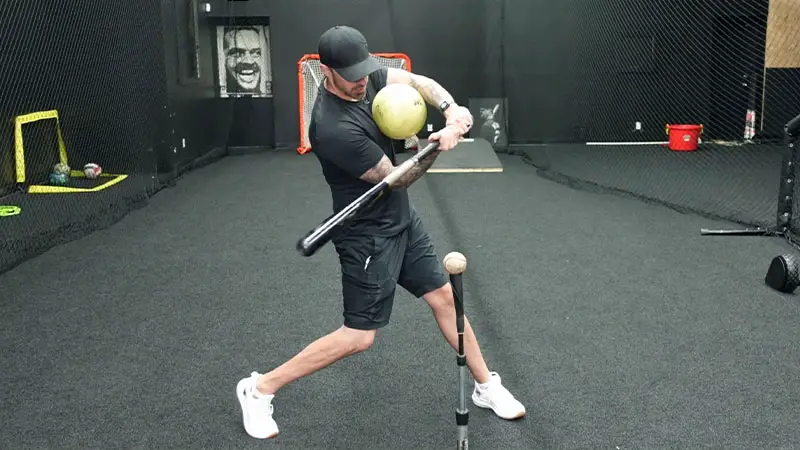Mastering the art of hitting in baseball can feel like an elusive dream, but with the right drills, you can transform your swing and boost your performance at the plate.
Whether you’re a seasoned player or just starting out, incorporating effective hitting drills into your practice routine is crucial. These drills address common issues and help develop a powerful, consistent swing.
Imagine stepping up to bat with the confidence that your stance and swing mechanics are finely tuned. Drills like the Catch and Crush Hitting Drill and the Ball Between the Legs Hitting Drill focus on key aspects such as creating torque and maintaining a proper stance.
By dedicating time to these exercises, you’ll see significant improvements in your hitting power and accuracy, making you a more formidable opponent on the field.
Baseball Hitting Basics
Baseball hitting is a fundamental skill that requires a combination of technique, timing, and strategy. Whether you’re new to the sport or looking to refine your skills, understanding the basics is essential.
Here’s a breakdown of key concepts to help you improve your hitting:
Importance of Hand-Eye Coordination
Hand-eye coordination is crucial for successful hitting in baseball. This skill determines how accurately you swing at each pitch and your ability to make contact on the sweet spot of the bat.
Training your eyes and hands to work seamlessly together ensures that the bat meets the ball at the right spot and time.
Enhance your hand-eye coordination with drills like hitting off a tee, soft toss, and live batting practice, focusing on tracking the ball from the pitcher’s hand to contact.
Key Hitting Mechanics
Correct hitting mechanics enable you to swing efficiently and make consistent contact with the ball. Core principles include a balanced stance, a compact swing, and controlled hitting motion.
Practice maintaining a balanced stance with your feet shoulder-width apart, knees slightly bent, and weight distributed evenly.
Your swing should stay compact with minimal extra movement, focusing on a direct path to the ball. Controlled motion ensures you remain steady throughout the swing, improving the likelihood of making solid contact.
Incorporate drills like tee work, soft toss, and front toss to reinforce these mechanics during practice.
Essential Baseball Hitting Drills
Hitting drills are crucial for improving technique, timing, and consistency at the plate.
Here are some essential drills to incorporate into your baseball training routine:
The Flamingo Drill
The Flamingo Drill, also known as the Front Leg Post Drill, focuses on balance and hitting mechanics. Start by standing on your back leg while lifting your front leg like a flamingo.
This position encourages balance and weight transfer. As you swing, ensure that your weight shifts smoothly from the back leg to the front leg. This drill helps prevent lunging and promotes a strong, balanced stance.
Incorporating the Flamingo Drill into your training regimen can significantly improve your hitting consistency. Practice this drill regularly to develop muscle memory and enhance your overall batting performance.
Full Turns
Full Turns activate your core and lower body to generate power. Extend the bat in front of you and take your normal stance.
Rotate your hips through the swing, aiming to get the knob of the bat to the pitcher. As you finish, your back should face the pitcher.
Practice this drill with and without a pause at the launch position to build timing and an explosive lower half. Full Turns enhance rotational strength and improve your swing’s effectiveness.
Incorporate these into your routine to develop muscle memory. Remember, consistency is key. Completing Full Turns regularly will refine your mechanics and lead to more solid contact during games.
Lower Body Coil
The Lower Body Coil drill strengthens your lower half, crucial for generating power. Start by standing in your batting stance and focus on loading your lower body.
Coil your hips and legs by rotating slightly inward as you prepare to hit. This action stores energy similar to a spring. As you initiate the swing, uncoil with force, driving through the ball. Consistent practice helps build muscle memory, ensuring powerful and controlled swings.
Additionally, incorporate visualization techniques to simulate game scenarios and increase effectiveness. Practicing this drill regularly will not only enhance your power but also improve your overall hitting mechanics.
K Posture Drill
For the K Posture Drill, hold a bat horizontally across your chest and stand in your hitting stance. This drill focuses on creating a strong posture and activating the lower body.
Mimic the letter “K” by keeping your shoulders square and tilted slightly forward. Practice rotating your hips while maintaining this posture.
The K Posture Drill ensures that your upper body remains stable while your lower body generates power, leading to more consistent and powerful swings.
Advanced Techniques and Drills
Mastering advanced techniques in baseball hitting requires focused practice and a deep understanding of mechanics.
Here are key techniques and drills to elevate your hitting skills:
Using a Heavier Bat for Speed Training
Using a heavier bat can significantly improve your bat speed. Training with a bat weighing 20-25% more than your usual bat helps strengthen muscles involved in the swinging motion.
Swinging the heavier bat enhances your conditioning, which translates to faster swings when you switch back to your regular bat. Ensure you maintain proper technique during these drills to avoid developing bad habits.
High and Low Tee Drills
High and Low Tee Drills target different pitch heights and reinforce correct swing mechanics.
High Tee Drill
This drill trains you to handle high pitches, working on a flatter bat path and upper body connection. The goal is to swing efficiently on high pitches instead of popping up or missing.
High Tee Drills benefit hitters struggling with high fastballs, high attack angles, or a push pattern during rotation.
Low Tee Drill
This drill helps you elevate low pitches and maintain proper posture. When executed correctly, it minimizes ground balls and improves swing consistency.
Low Tee Drills address early extension issues and low attack angles, enhancing your ability to drive low pitches effectively.
Soft Toss Drills
Soft Toss Drills are versatile and highly effective for improving your timing, hand-eye coordination, and swing mechanics.
A coach or partner tosses balls underhand from the side, allowing you to work on various aspects of your swing.
This drill can be customized to focus on specific elements:
Line Drive Focus
Aim to hit line drives through a designated tunnel or to a target, ensuring consistent, solid contact with the ball.
This drill helps improve bat speed, hand-eye coordination, and overall hitting efficiency. Incorporate it into regular practice sessions to see measurable improvements in game performance.
Hitting to All Fields
Practice hitting balls to different parts of the field, developing adaptability and better control over your swing.
This can be further enhanced by incorporating tee drills and soft toss sessions, which help refine your mechanics and timing. Consistent practice builds muscle memory, leading to improved performance.
Reaction Time
Increase toss speed or use varied timing to improve your quick reflexes and adapt to different pitch scenarios.
Additionally, incorporating these drills into your routine can help you perfect your swing mechanics and increase overall batting accuracy. Ensure to practice consistently for optimal results.
Drills for Specific Skills
Improving specific skills in baseball hitting requires targeted drills that focus on technique, timing, and adaptability.
Here are drills designed to enhance key aspects of your hitting game:
Batting Practice Drills
Batting practice drills enhance various aspects of your swing, from mechanics to decision-making. Set up a practice routine that includes live pitching sessions and soft toss drills.
Live pitching allows you to adapt to different pitch types and speeds, improving your reaction time. Soft toss drills help focus on hand-eye coordination and timing as you try to hit balls tossed from the side.
- Live Pitching Sessions: React to varying speeds and types of pitches.
- Soft Toss Drills: Enhance timing and coordination with side tosses.
- Situational Hitting: Practice hitting in specific game scenarios to improve strategic thinking.
Two Tee Drill
The Two Tee Drill isolates swing mechanics and targets different pitch locations. Set one tee for inside pitches and another for outside pitches.
This setup allows you to practice hitting to various parts of the field, improving your ability to handle all pitch types.
- Inside Pitch Tee: Focuses on compact swings for inside balls.
- Outside Pitch Tee: Encourages extending the bat for outside balls.
- Pitch Location Visualization: Visualize different pitches to improve decision-making.
Grounders Only Tee Ball
The Grounders Only Tee Ball drill focuses on producing ground balls by adjusting your swing path. Place the tee lower than usual and aim to drive the ball down into the ground.
This drill helps refine your ability to make contact and control the ball’s trajectory, essential for infield hits.
- Low Tee Placement: Set tee lower to emphasize ground ball production.
- Controlled Swing Path: Adjust swing to focus on hitting the ball down.
- Trajectory Control: Practice consistent contact for better infield hits.
Training Strategies for Different Age Groups
Tailoring training strategies to different age groups in baseball hitting is crucial for development and success.
Here are strategies suited for various stages of player development:
Youth Player Drills
Youth players need engaging drills to develop fundamental hitting skills while nurturing a love for the sport. Start with Tee Work to improve swing mechanics.
Place the ball on a tee and focus on hitting consistent line drives. Use Soft Toss for timing and hand-eye coordination, where a coach underhand throws the ball to the hitter from the side.
Add Coach Pitch for live pitch experience, emphasizing pitch recognition and timing. Integrating these drills helps build a strong foundation in hitting.
High School Player Drills
High school players should refine their hitting mechanics and adapt to faster pitches. Begin with Advanced Tee Drills to simulate different pitch locations.
Use the Two Tee Drill to practice hitting inside and outside pitches accurately. Utilize Live Batting Practice for real-game scenarios, focusing on pitch speed and pitch type.
Incorporate Heavier Bat Training to increase bat speed and strength. Add Visualization Exercises to mentally prepare for at-bat situations, imagining successful hits. These drills ensure high school players are versatile and strategic hitters.
Frequently Asked Questions
What are the key drills for mastering hitting in baseball?
Essential drills include hitting off a tee, soft toss, and live batting practice. These drills focus on achieving balance, maintaining a compact swing, and improving hand-eye coordination.
What advanced techniques can help improve hitting?
Advanced techniques involve using a heavier bat, high and low tee drills, and specialized soft toss drills. These drills are designed to enhance reaction time, coordination, and power.
What are some batting practice drills to improve hitting skills?
Effective batting practice drills include live pitching sessions and soft toss drills. These help improve reaction time and overall coordination, making hitters more versatile.
How can the Two Tee Drill help a hitter?
The Two Tee Drill targets different pitch locations, helping hitters develop the ability to hit balls in various strike zones, thereby increasing their versatility at the plate.
What is the purpose of the Grounders Only Tee Ball drill?
The Grounders Only Tee Ball drill is designed to produce ground balls. This drill helps hitters focus on hitting the lower half of the ball, which is useful for creating grounders in game situations.
Conclusion
Mastering baseball hitting requires dedication to a variety of drills that enhance your balance, swing mechanics, and hand-eye coordination.
Incorporating both basic and advanced techniques can make a significant difference in your performance at the plate.
Tailoring your training to your age and skill level ensures that you develop the necessary fundamentals and refine your mechanics as you progress.
By consistently practicing these drills, you’ll become a more versatile and strategic hitter, ready to face any challenge on the field.
Some effective drills include tee work to perfect your swing path, soft toss to improve timing, and live batting practice to simulate game situations.
Combining these drills with video analysis can further refine your technique, helping you identify areas for improvement.








Pat Bloom